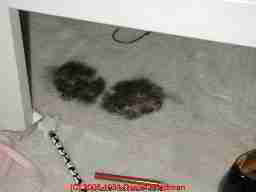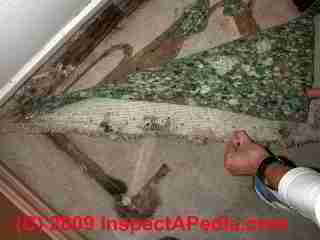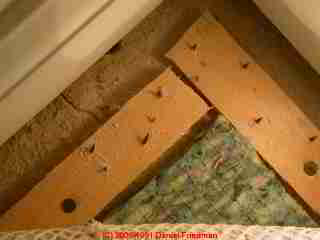 Carpeting & Indoor Air Quality Improvement
Carpeting & Indoor Air Quality Improvement
- POST a QUESTION or COMMENT about the relationship between indoor carpeting & indoor air quality
Effects of carpeting on buildin gindoor air quality:
This article explains possible effects of carpeting on indoor air quality in homes, including the emission of VOCs, formaldehyde styrene, and odors from other sources such as carpet mold.
InspectAPedia tolerates no conflicts of interest. We have no relationship with advertisers, products, or services discussed at this website.
Carpeting and Indoor Air Quality, Health Effects
 This article includes excerpts or adaptations from Best Practices Guide to Residential Construction (Steve Bliss, J Wiley & Sons) , by Steven Bliss, courtesy of Wiley & Sons.
This article includes excerpts or adaptations from Best Practices Guide to Residential Construction (Steve Bliss, J Wiley & Sons) , by Steven Bliss, courtesy of Wiley & Sons.
As discussed in Best Practices Guide to Residential Construction
Concerns about the health effects of carpeting first gained national attention in 1988 when new carpeting installed at the EPA headquarters in Washington, D.C., was linked to a rash of health complaints among EPA staff.
While a definitive cause never was identified, experts focused on two main compounds:
- The solvent-based adhesive used to install the carpeting and
- The chemical 4-PC (4-phenylcyclohexene), a compound found in the synthetic latex backing used in 95% of all U.S. carpets. The compound 4-PC gives carpeting its distinctive “new carpet” odor and is detectable by most people at very low levels.
Styrene, a known health hazard and suspected carcinogen, is also found in the latex backing on carpeting.
Since 1988, over 500 people have made complaints to the Consumer Products Safety Commission (CPSC) about new carpeting.
The most frequently reported symptoms have been watery eyes, runny nose, burning sensation in the eyes, nose, and throat, headaches, rashes, and fatigue. In response, the CPSC commissioned a study of off- gassing from new carpeting and identified 31 compounds, but none approached airborne levels known to be hazardous for short-term exposure.
Long-term effects of exposure to these carpet-associated chemicals or gases were not studied.
While some suspected formaldehyde , a common respiratory irritant, it has not been used in the manufacture of U.S. carpeting since the late 1980s (with the exception of some vinyl-backed carpet tiles used in commercial installations).
Carpet Labeling Program Identifies VOCs, styrene, 4-PC & Formaldehyde

The Carpet and Rug Institute (CRI), an industry association representing carpeting manufacturers, also took action by launching its “Green Tag” program in 1992.
The voluntary program tests new carpeting for four categories of emissions: total VOCs, styrene, 4-PC, and formaldehyde.
Since national standards do not exist for carpet emissions, the industry established its own acceptable levels.
While these might not be as stringent as some health advocates would like, they have led to a lowering of emissions by manufacturers eager to display the Green Tag label.
Labeling Program for Carpet Padding & Carpet Adhesives
Since 1992, the CRI program has expanded to include carpet pads and adhesives, suspected by some to be a greater source of volatile compounds than the carpeting itself.
Also, while no chemical stands out as the source of most complaints, the synergistic effect of multiple compounds is not well understood.
 Also, the sensitivity to chemical emissions
varies among individuals, making the effects of new carpeting
on individual occupants difficult to predict.
Also, the sensitivity to chemical emissions
varies among individuals, making the effects of new carpeting
on individual occupants difficult to predict.
Air Out Carpet Before Installation or Occupancy
Both CRI and independent health advocates agree that new carpet emissions drop off rapidly in the first 24 to 72 hours after being unrolled and exposed to ventilation air.
By increasing ventilation during that time, or if possible, airing out the carpet for several hours to several days before installation, most of the chemical emissions can be avoided. In glue-down installations, seek out low-VOC adhesives rated at less than 50 grams of VOC content per liter of adhesive.
Carpeting Alternatives for Sensitive Individuals.
Once installed, carpets can act as reservoirs for contaminants filtered from the air or tracked in on shoes, including hydrocarbons, pesticides, and other particulates.
Also, in high-humidity conditions, dust mites, a powerful allergen, can thrive in carpets. In homes with small children, people with allergic conditions, or high-sensitivity individuals, consider alternatives to carpeting. Area rugs that can be washed periodically in 130°F water are an option.
Where carpeting is installed, health experts recommend frequent vacuuming with a HEPA-type vacuum or central vacuum with an outside exhaust, and periodic deep cleaning using a hot-water extraction system.
-- Adapted with permission from Best Practices Guide to Residential Construction (Steve Bliss, J Wiley & Sons) .
...
Continue reading at CARPET PADDING ASBESTOS, MOLD, ODORS or select a topic from the closely-related articles below, or see the complete ARTICLE INDEX.
Or see these
Recommended Articles
- CARPETING & INDOOR AIR QUALITY
- ASBESTOS in CARPETING, PADDING
- CARPET DUST IDENTIFICATION
- CARPET FUNGICIDAL SPRAY
- CARPET MOLD / ODOR TESTS
- CARPET PADDING ASBESTOS, MOLD, ODORS
- CARPET STAIN DIAGNOSIS
- CARPET STAINS by AIR LEAKS
- CARPET STAIN ID TESTS
- CARPET TACK STRIPS & FLOODS
- CARPET AIR LEAK STAINS at WALLS
- CARPET CONTAMINATION TEST PROCEDURE
- OZONE MOLD / ODOR TREATMENT WARNINGS
- CARPETING, SELECTION & INSTALLATION
- HOUSE DUST CHEMICAL CONTAMINANTS
Suggested citation for this web page
CARPETING & INDOOR AIR QUALITY at InspectApedia.com - online encyclopedia of building & environmental inspection, testing, diagnosis, repair, & problem prevention advice.
Or see this
INDEX to RELATED ARTICLES: ARTICLE INDEX to BUILDING INDOOR AIR QUALITY IAQ
Or use the SEARCH BOX found below to Ask a Question or Search InspectApedia
Ask a Question or Search InspectApedia
Try the search box just below, or if you prefer, post a question or comment in the Comments box below and we will respond promptly.
Search the InspectApedia website
Note: appearance of your Comment below may be delayed: if your comment contains an image, photograph, web link, or text that looks to the software as if it might be a web link, your posting will appear after it has been approved by a moderator. Apologies for the delay.
Only one image can be added per comment but you can post as many comments, and therefore images, as you like.
You will not receive a notification when a response to your question has been posted.
Please bookmark this page to make it easy for you to check back for our response.
Our Comment Box is provided by Countable Web Productions countable.ca
Citations & References
In addition to any citations in the article above, a full list is available on request.
- Carpet fibers and padding, Kathryn A. Hairle, [may be unavailable], University of Wisconsin Cooperative Extension, 1975
- Handbook of Fiber Finishing Technology, Philip E. Slade, 1997, [Quoting Amazon.com]
Gathering hard-to-obtain data from different fiber and fabric manufacturers and suppliers into a single, convenient volume, this practical handbook supplies detailed information on hundreds of textile finish components;including their structural formulae, physical properties, CAS numbers, and effects on various fibers. Promoting a deeper understanding of finish technology, the Handbook of Fiber Finish Technology covers the fundamentals of fiber finish science, such as theories of friction laboratory testing of formulations from preliminary component evaluation to analyses for material characterization the influence of wetting, emulsification, and finish distribution on coatings soil- and stain-resistant chemicals and their applications in carpet protection the degradation of chemicals in the environment, including methods for predicting waste degeneration and more! Complemented with bibliographic citations and nearly 500 tables, equations, and drawings, this expertly written handbook is invaluable for polymer, fiber, and textile chemists, scientists, and engineers; physical, surface, and colloid chemists; textile and fiber manufacturers; and graduate-level students in these disciplines. - Rug and carpet fibers: Selection and Care, Shirley M. Niemeyer
- Rugs and Carpets - Padding, Patsy Keller, [may be unavailable],
- Rug pulled out from recycling: carpet padding recycling is taking a big hit ...(polybrominated diphenyl ethers presence, Ed Thornhill, Construction & Demolition Recycling (Magazine/Journal), 2005
- Tufted Carpet: Textile Fibers, Dyes, Finishes, and Processes, Von Moody, Howard L. Haber, [Quoting from Amazon]
This book combines Von Moody's original work and research in the carpet industry with the well respected 1986 textile source book, Textile Fibers, Dyes, Finishes, and Processes: A Concise Guide, by Howard L. Needles to produce a unique practical guide on all aspects of the preparation, manufacture, and performance of carpet. It addresses the structure and properties of fiber, carpet construction, coatings, dyes, finishes, performance, and recycling, among other topics. This volume is an indispensable reference for all practitioners in the carpet industry. - Our recommended books about building & mechanical systems design, inspection, problem diagnosis, and repair, and about indoor environment and IAQ testing, diagnosis, and cleanup are at the InspectAPedia Bookstore. Also see our Book Reviews - InspectAPedia.
- Decks and Porches, the JLC Guide to, Best Practices for Outdoor Spaces, Steve Bliss (Editor), The Journal of Light Construction, Williston VT, 2010 ISBN 10: 1-928580-42-4, ISBN 13: 978-1-928580-42-3, available from Amazon.com
- In addition to citations & references found in this article, see the research citations given at the end of the related articles found at our suggested
CONTINUE READING or RECOMMENDED ARTICLES.
- Carson, Dunlop & Associates Ltd., 120 Carlton Street Suite 407, Toronto ON M5A 4K2. Tel: (416) 964-9415 1-800-268-7070 Email: info@carsondunlop.com. Alan Carson is a past president of ASHI, the American Society of Home Inspectors.
Thanks to Alan Carson and Bob Dunlop, for permission for InspectAPedia to use text excerpts from The HOME REFERENCE BOOK - the Encyclopedia of Homes and to use illustrations from The ILLUSTRATED HOME .
Carson Dunlop Associates provides extensive home inspection education and report writing material. In gratitude we provide links to tsome Carson Dunlop Associates products and services.

